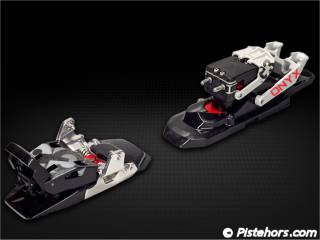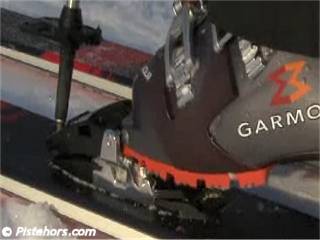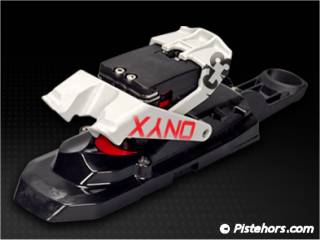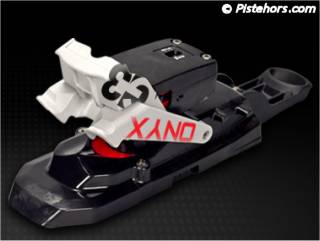G3 previews Onyx Dynafit compatible binding
After one of the key Dynafit patents covering technology in the toe-piece ran out it was only a matter of time before rivals launched complete bindings, not just heels such as the skeletal XP50, that are compatible with the Dynafit equipped boots.

Onyx Dynafit compatible binding
First out of the blocks is Canadian firm G3 with the Onyx. Currently a prototype it is scheduled to hit the shops in the winter of 2009/10. The engineers at G3 have set out to overcome some of the shortcomings with Dynafit’s design. The thing is, it is a bit like Gillette’s five blade razors with aloe lubricating strips, if you get a perfectly good shave with a 2 blade Bic at a fraction of the cost and weight you may not even be aware of the shortcomings.

Easy step in toe piece
Two things strike you when you look at the Onyx. Gone is the Dynafit simplicity, this binder looks complicated. The heel piece vaguely resembles a 1980s Marker binding mated with the ill fated Dynafit Tri-Step toe piece. The Onyx is also seriously heavy, at least for a Dynafit user. 1430 grammes (with screws, G3 reminds us). I could have a Silvretta Pure for that kind of weight and not bother with boots with Dyna inserts.
So what are the problems with Dynafit’s bindings? Ask a group of users and you get some consensus:-
i. Getting into the bindings can be a pain, particularly on steep slopes
ii. Changing the heel lift by rotating the heel piece with pole or hand requires some skill
iii. Toe pieces can be hard to lock and are subject to icing
iv. You need to remove your boots to switch from tour to ski mode
v. Boot length adjustment is in the heel only, change boots and you can end up off center on your skis
vi. Heels can spin round when touring locking heels
vii. The plastic parts are somewhat fragile

Onxy with mid heel lift, note heel pins are covered
Experienced users hardly notice the above but they can lead to frustrations for occasional or novice users. There are work-arounds and Dynafit have made some improvements such as adding grooves to the toe inserts of their Zzero boot range to aid alignment and adding more leverage on the locking lever of the Vertical models. Boot alignment on Dynafits can be aided by putting the heel in tour mode, with the boot placed firmly into the heel piece the toes should be aligned with the toe jaws.
The first change on the Onyx is a heel piece that slides back and forth rather than rotating. The heel is locked by a large lever at the back of the binding that can be operated with a ski pole. It is now possible to easily switch the binding from tour to ski mode without removing your boot. This is useful if you want to descend a short section while keeping your skins on and prefer the security of a locked heel. If the bindings were lighter it would also appeal to ski mountaineers wishing to make fast changes from climb to descent. However these users are adept at directly switching from tour to ski mode with Dynafit bindings, something that is facilitated with bellows boots like the Scarpa F1.
The Onyx is attached to the ski via mounting plates that are separate units. The bindings can be removed from skis with a bit of fiddling. We are not really sure why you would need to do this. However it does give you 33mm of boot adjustment (similar to the Vertical) with the advantage that the toe has three positions with 15mm of adjustment which will keep boots centered over the ski, a bit like alpine rental bindings.
The toe lever has plenty of leverage and a pole shaped slot if you need to apply more force. Heel lift can be easily operated by a pole and offers medium and high positions. The construction is a mix of forged aerospace grade aluminium for high strength parts and fibre reinforced plastic. Breakages are not exactly common with Dynafit and we wonder if the Onyx is over engineered. At least this will provide some scope for weight savings once G3 have a season or two of field use. The bindings will be available with ski brakes and crampons.

Onyx with upper heel lift
At around $400 the Onyx is priced against the Dynafit Vertical ST/FT. It weighs 43% more than the ST but should be easier to use. However the Vertical FT offers a maximum DIN of 12 compared to the Onxy with 10. For burly riders skiing hard and packing a large ruck-sack this could be a deal breaker.
So who is going to buy the Onyx? Well G3 (Genuine Guide Gear) is a Canadian company based in Vancouver with a good reputation. With effective marketing and distribution in North America they might do well in that market, especially if they produce brakes and crampons that can be used on 92mm plus skis. Rather than comparing the weight of the Onyx with a Dynafit TLT (730 grammes) it should be set against the well received Marker Duke (2600 grammes). With the widespread availability of boots using the “Tech” system (G3 seem unable to utter the words Dynafit) Duke users may decide to equip a pair of skis with the Onyx for longer tours. The ease of use would appeal to occasional tourers.
Having experienced teething troubles with both the Silvretta Pure and the Naxo Nx01 we wonder whether the mechanism of the Onxy will be robust enough for the abuse of ski touring. We would also be concerned about icing, especially given the differences in American and European snow conditions. Will the Onxy be a success? Increase the DIN to 12 and loose 200 grammes and we would say yes, after all even the 5 bladed Gillette gives a closer shave.
Now we are waiting for the Black Diamond binding, made in China, of course.
Further Information
G3 have a very complete website for the Onyx: http://www.g3onyx.com/
Posted by
davidof on Tuesday, 13 January, 2009 at 10:40 PM
QUOTE: “However these users are adept at directly switching from tour to ski mode with Dynafit bindings, something that is facilitated with bellows boots like the Scarpa F1”
Would you be kind enough to explain how bellows boots help with speedy transitions? Can stepping out of the DF bindings be completely avoided with these boots? I ski a lot of rolling terrain on Karhu XCD guides (sometimes climbing with skins, but often without), and am trying to decide between DF TLT and G3 Onyx bindings, and also whether to get Scarpa F1 or F3.
Cheers
Julian
Posted by on Saturday, 23 May, 2009 at 04:26 PM
I tried the unit they had at Mountain Equipment Coop in Vancouver on display. It was near impossible to apply enough pressure to open the toe jaws.
The Onyx videos says ‘How to Easily’ do this, but there is not easy way. It’s difficult even when putting a lot of body weight on the lever.
I weight 201 lbs and had trouble opening it by pressing down with a ski pole.
If it wasn’t for this I would have ought the binding.
Posted by on Tuesday, 24 November, 2009 at 03:01 AM
Maybe the production bindings will be a bit smoother? They have them at the local store so I must go and check them out.
Posted by
davidof on Tuesday, 24 November, 2009 at 09:34 AM
I have recently had an issue with one of the toe pins snapping off my Onyx bindings! Does anyone know of this happening with Onyx bindings (or even Dynafit bindings)? On examination of the failiure point there appeared to be a defect in the metal and it failed under fatigue (I’m 65kg and I’ve had them for three seasons of moderate use). Luckily this happend whilst getting into them on a ski field. Had it snapped whilst skiing or away on a multiday tour it would have been catastrophic!
Posted by on Thursday, 29 September, 2011 at 11:53 PM
Do you guys still accept posts?
http://pistehors.com/
Posted by on Wednesday, 27 February, 2013 at 10:17 PM
Comments are now closed




